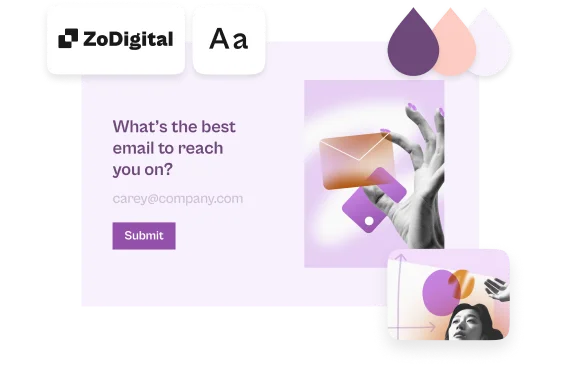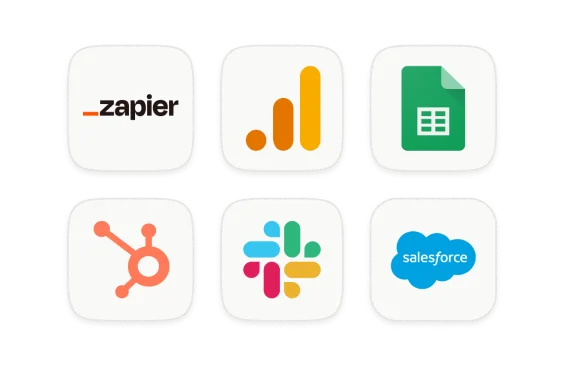10 tips for building effective churn surveys
It’s always hard to say goodbye to one of your users, but customers who churn can also give valuable feedback on how to make your business better. Use Typeform to design a smart churn survey that can help lower overall churn over time and turn more farewells into ‘be back soon’.
Typeform’s array of question types and Logic options give you the flexibility to get creative with the survey you send. But before you start building, it’s important to think about what you’re hoping to learn from the survey, and how you can best follow up with the answers you receive. Check out our sample churn form below, and read on for churn survey tips to get you off the ground:
Jump to:
- Figure out your goals
- Reach out sooner, rather than later
- Collect demographic info wisely
- Be mindful of respondents’ time
- Own up to former users
- Cast a wide net for feedback
- Provide a tailored survey experience
- Develop a follow-up strategy
- Always be improving - your churn survey, too!
- Make churn surveys part of a feedback lifecycle
1. Figure out your goals
Churn surveys are pointless if they don’t lead to concrete action: learning from a churn survey should help both you and your customers. Before designing your survey, take some time to work out where your organization stands, and what opinions you might need to hear.
For example, let’s say that your company shares the market with several competitors, and you’re interested in knowing how your customer service and integration offerings stack up with theirs. Churn surveys commonly include a question like “What was the single-biggest reason you left?” You can use Typeform to create a Multiple Choice question with answer choices about your areas of concern:
You can also include Rating, Opinion Scale, or Matrix questions that ask how important different areas were to a user’s decision to churn:
2. Reach out sooner, rather than later
Sending out a survey soon after a customer has canceled their subscription lets you capture their thoughts while they’re still fresh.
To make sure that you don’t miss out on any former accounts, use a marketing automation software like HubSpot, ActiveCampaign, or Autopilot—you can integrate Typeform with all of them 🙌—to automatically email surveys to churned accounts.
You can also link to or embed the survey form in your website, so that it appears in the user’s browser as soon as they’ve canceled their subscription.
3. Collect demographic info wisely
Segmenting your respondents gives valuable context about which user groups you could do a better job serving. When it comes to churn surveys, though, it’s best to err on the short and sweet side. You can use Short Text and Email questions to collect details about respondents in your form, but the smart move is to use other tools in your arsenal to include information you already have!
You can use Hidden Fields and a marketing software like Autopilot to automatically send the survey to former customers, while including relevant account information in the form URL. This information is then visible in the form’s Results panel.
Here’s the demographic information we capture using Hidden Fields:
- Account ID – identifying each respondent
- Plan – what plan the respondent was on
- Signup date – when respondents joined Typeform
- Last invoice date – when respondents left Typeform, approximately
And here’s an example of how the form URL might look with the Hidden Fields included:
https://example.typeform.com/to/ABCDEF?userid=&plan=&signup=&lastinvoice=

Note! When using Hidden Fields to identify respondents, you may want to use a field like Account ID or User ID that’s unique to your organization. This avoids GDPR-related issues with handling personal data.
4. Be mindful of respondents’ time
Respect should guide every interaction with potential, current, or former users. Typeform’s question-by-question experience prevents respondents from being overwhelmed by a long churn survey. You can work behind the scenes to make sure people are only seeing the questions that are relevant to their experience.
Aim for a short survey—two to four questions is best. Before sending it out, toggle on Time to complete in your Welcome Screen, if using one, to show upfront how long completion will take. (If Time to complete is longer than a few minutes, consider using Logic or removing questions—shorter forms have a higher completion rate!)
Take advantage of Logic to show respondents only those questions that reflect their experience. For example, let’s say your form starts off by asking for the main factor that made a respondent leave your service:
If a respondent answers ‘I need new features’, show them a follow-up Long Text question that asks which features would have been useful:
To make sure that the follow-up question is only shown when relevant, open Branching, segmentation and calculations from the Logic tab in the right-hand sidebar of the Typeform Create panel. Set up a Logic rule like so:
Repeat this process with any other follow-up questions you might have.
5. Own up to former users
Churn surveys give you a chance to uncover the real reasons behind your users’ decision to leave. Honest feedback can be hard to hear, but it’s more helpful for creating a better product experience down the road.
When writing your survey, use language that promotes sincere responses. One option is to leave a message on your Welcome Screen encouraging respondents to be direct:
Make sure to avoid hinting that you blame the user for deciding to leave, or that you think they made a mistake. For churn surveys, the name of the game is your own team’s openness to growth and improvement.
6. Cast a wide net for feedback
Churn surveys come at a delicate time. Your former customers might be disappointed or angry with their experience, so it’s crucial to let them know that they’ll be listened to.
To make sure that all your respondents can have their say, leave space for open-ended responses in your churn form. Use the ‘Other’ option to give more flexibility on Multiple Choice questions:
Or add a Long Text question at the end of the form to gather any remaining thoughts:
7. Provide a tailored survey experience
Use Logic to show respondents different Ending screens based on their responses to prior questions. Here, we’ve used the Ending to showcase upcoming Typeform initiatives. Users who mentioned missing features as the reason for churning get an invite to a webinar on new feature developments:
To set this up, change the button link on the End Screen to take respondents to an event signup page:
Here’s the Logic that will show that Ending to respondents who were concerned about missing features:
Make sure to also set up Logic that will take the rest of your respondents to the right Ending screen.
8. Develop a follow-up strategy
Churn surveys should give all respondents a chance to speak their mind, but you might want to follow up in depth with certain former users to get a stronger idea of how to better match their needs. You can use Logic to send some respondents—for instance, those who mentioned missing features as a reason for churning—to an Appointments question, where they can set up an interview with your team.
To make churn survey feedback actionable, it’s also a good idea to incorporate it into the tools your team already uses. Typeform’s Slack integration sends responses into a Slack channel of your choice, where employees can quickly be notified about feature requests or any bugs that impacted user experience:
You can also use our integrations for Google Sheets to easily analyze quantitative feedback, or a CRM tool like HubSpot or Salesforce to link feedback to specific user profiles.
9. Always be improving - your churn survey, too!
Over time, as your organization develops and your priorities shift, make sure that your churn survey and follow-up strategies adapt to better represent the information you’d like to collect.
Track the survey’s performance in the Insights tab of the Results panel. Here, you can see the number of starts, as well as the question-by-question dropoff rate. If your completion rate is too low for your liking, or you notice that certain questions have a high dropoff rate, it might be time to rethink your survey design or offer incentives for completion.
10. Make churn surveys part of a feedback lifecycle
While it’s always great to hear from users, it’s bittersweet to gather their feedback after they’ve already left your service. Make sure that churn surveys are only one part of a broad feedback-gathering strategy, where users regularly get chances to share their thoughts and your organization can act proactively to improve their experience.
A well-crafted churn survey will make itself less and less important over time. Put the feedback you receive into play, and you’ll be rewarded with happier users who stick around for longer.


